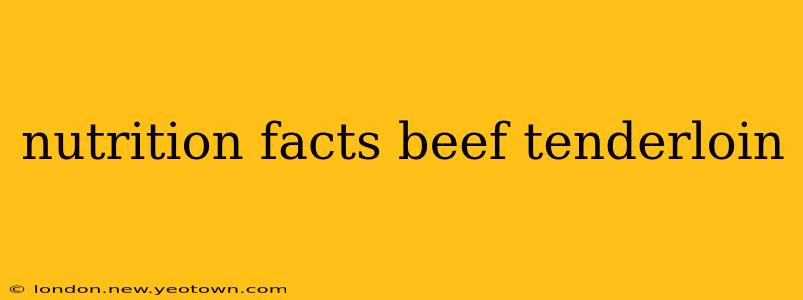The aroma of perfectly seared beef tenderloin, its succulent texture promising a delightful culinary experience – it's a scene many of us crave. But beyond the exquisite taste, lies a nutritional profile worth exploring. This isn't just a gourmet treat; it's a source of essential nutrients that contribute to a balanced diet. Let's delve into the fascinating world of beef tenderloin nutrition facts, answering some frequently asked questions along the way.
What are the nutritional benefits of beef tenderloin?
Beef tenderloin is a lean cut of meat, meaning it's lower in fat compared to other cuts. This makes it a great option for those watching their fat intake. However, "lean" doesn't mean devoid of nutrients. This prized cut packs a punch with protein, essential for building and repairing tissues, crucial for muscle growth and overall bodily functions. It’s also a good source of iron, vital for oxygen transport in the blood, and various B vitamins, contributing to energy production and nerve function. Think of it as a nutrient-dense powerhouse subtly delivering vital components to keep you going.
How much protein is in a 3-ounce serving of beef tenderloin?
A typical 3-ounce serving of beef tenderloin boasts approximately 22-25 grams of protein. This substantial amount makes it an ideal choice for athletes, individuals seeking muscle growth, or anyone aiming to increase their daily protein intake. This protein content contributes to satiety, meaning it helps you feel fuller for longer, potentially aiding in weight management when part of a balanced diet.
Is beef tenderloin high in cholesterol?
This is a question frequently raised regarding red meat. While beef tenderloin does contain cholesterol, the amount is comparable to other lean cuts of meat. It's important to note that dietary cholesterol's impact on blood cholesterol levels is less significant than previously believed. However, moderation is key, particularly for individuals with pre-existing health conditions or those managing cholesterol levels. A balanced diet incorporating a variety of foods is always recommended.
How many calories are in a 3-ounce serving of beef tenderloin?
The calorie count in a 3-ounce serving of beef tenderloin typically ranges from 170 to 200 calories, depending on preparation methods. Remember that added fats from cooking methods like butter or oil can significantly increase the caloric content. Grilling, broiling, or pan-searing with minimal added fat are healthier choices that keep the calorie count lower while retaining the exquisite flavour.
Is beef tenderloin a good source of iron?
Absolutely! Beef tenderloin is an excellent source of heme iron, a type of iron easily absorbed by the body. This makes it particularly beneficial for individuals at risk of iron deficiency, such as pregnant women or vegetarians who may not consume enough iron-rich foods. Heme iron is superior in absorption to non-heme iron found in plant-based sources.
What are the best ways to cook beef tenderloin?
The delicate nature of beef tenderloin necessitates careful cooking to achieve optimal tenderness and juiciness. Grilling, broiling, roasting, and pan-searing are all excellent methods that allow you to showcase its natural flavors without overcooking. Remember to use a meat thermometer to ensure it reaches the desired internal temperature for food safety and optimal texture – avoiding overcooking is paramount for tenderness!
In conclusion, beef tenderloin offers a delicious and nutritious addition to a balanced diet. Its high protein content, essential vitamins and minerals, and relatively lean profile make it a versatile and healthful choice, provided it’s consumed as part of a mindful, well-rounded eating plan. Remember to always consult with a healthcare professional or registered dietitian for personalized dietary advice.

